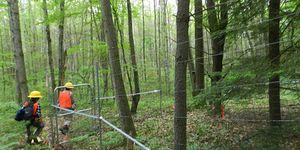Molecular Motor Driving Chromosome Transformation is Identified
Chromosomes have to be organized into three-dimensional structures from loose tangles, through a process called loop extrusion. It had been proposed that a protein complex named cohesin was probably responsible for taking chromosomes from tangles to a series of expanding loops, but that was not proven until now. Scientists at MIT and the Pasteur Institute in France have demonstrated that cohesin is the motor driving loop extrusion.
The video above animates the dynamics of loop extrusion. Cover photo is a screenshot. Credit: Imakaev, Fudenberg, and the Mirny lab at MIT
"Each of these machines lands on the DNA and starts extruding loops, but there are boundaries on DNA that these motors cannot get through," explained Leonid Mirny, a Professor of Physics at MIT's Institute for Medical Engineering and Sciences. "So as a result of this motor activity, the genome is organized into many dynamic loops that do not cross the boundaries, so the genome becomes divided into a series of neighborhoods." These neighborhoods are referred to as known as topologically associating domains (TADs).
Mirny led the work along with Francois Spitz at the Pasteur Institute. The research team has also identified another mechanism that does not use cohesin to separate inactive and active regions of DNA, organizing them into different compartments in the nucleus of the cell.
A molecule called Nipbl loads cohesin onto DNA, so the team began their investigation into cohesin's function by ablating Nipbl. A technique called Hi-C, created by Professor Jacob Dekker, has previously been used to reveal the existence of TADs. Hi-C allowed the researchers to capture and sequence regions of DNA that are in close physical proximity. It can help show how many physical interactions are occurring at different places on a chromosome.
After deleting the Nipbl molecule from mice, the investigators discovered that the TAD neighborhoods had virtually disappeared. But the compartmentalization of active and inactive areas of the genome had gotten even more pronounced. The team suggested that the cohesin motors enable every gene to reach the regulatory elements that switch genes on and off.
Additional work reported in Cell has demonstrated that another protein called CTCF interrupts the cohesin motors. The Mirny lab worked with researchers at the University of California at San Francisco and the University of Massachusetts Medical School to show that CTCF is necessary to retain proper gene regulation. It functions to set the boundaries of the neighborhoods, which must stay separate.
"Cohesin is central for gene regulation, and we emphasize that this is a motor function, so it is not just that they (genes and regulatory elements) find each other somewhere randomly in space, but they were brought together by this motor activity," Mirny explained. A 2016 talk by Mirny is featured in the following video.
"In this work, the Mirny and Spitz labs combine mouse models with genomic approaches to study chromosome folding to reveal that the machine that loads the cohesin complex is critical for TAD formation," commented Dekker, who was not involved in this work. "From this and another previous study, a molecular mechanism is coming into view where TADs form by cohesin and Nipbl-dependent chromatin loop extrusion, which is blocked by sites bound by CTCF."
Next, the scientists want to characterize how a loss of the molecular motor impacts gene regulation. Computer simulations are being performed to determine how loop extrusion with cohesin occurs simultaneously with the segregation of the genome into active and inactive regions.
"It's like two pianists playing on the same piano," noted co-author Nezar Abdennur, a doctoral candidate in the Mirny lab. "They interfere and put constraints on each other, but together they can produce a beautiful piece of music."
You can check out a video about the Hi-C method from JoVE, the Journal of Visual Experiments, here.








